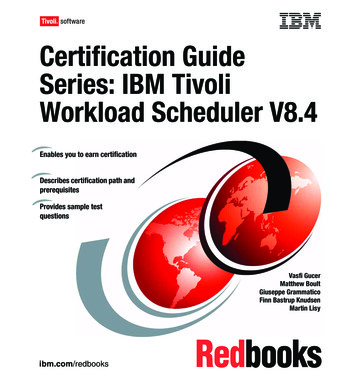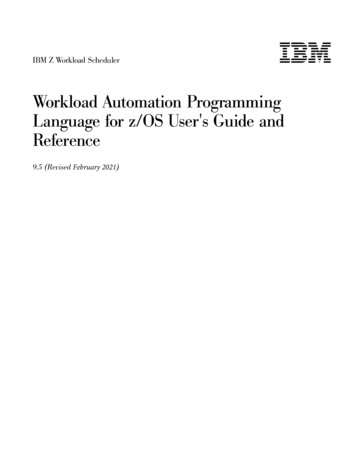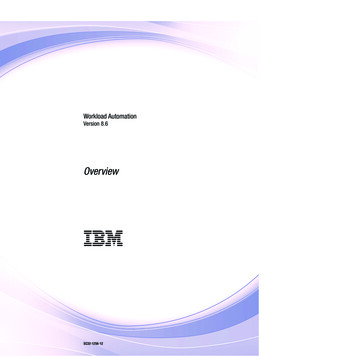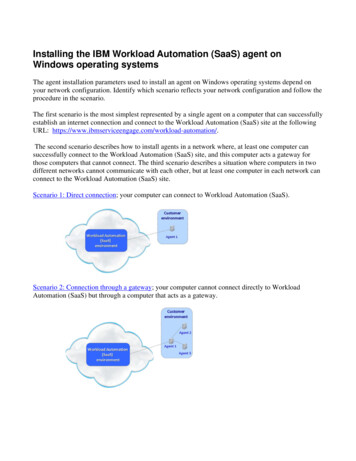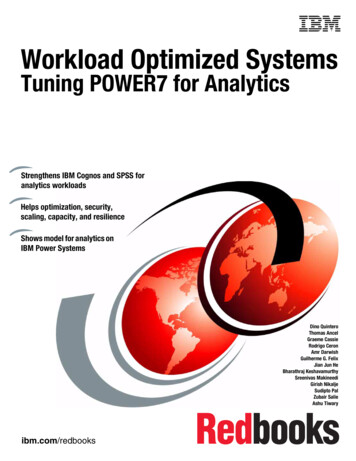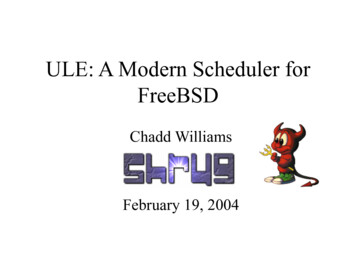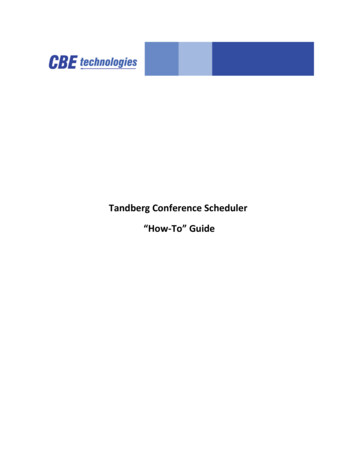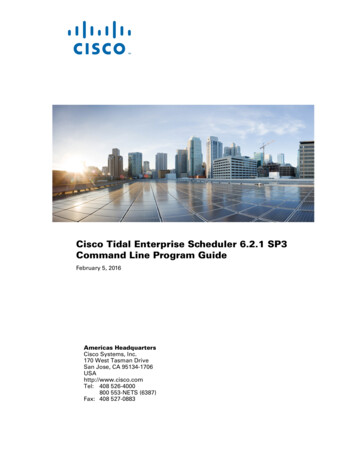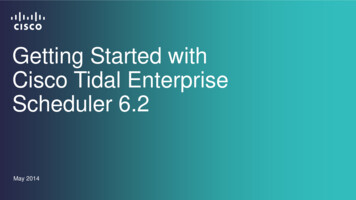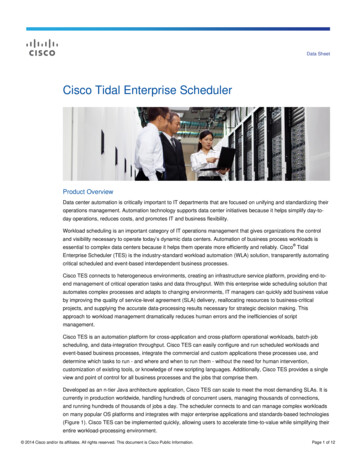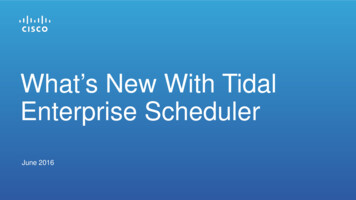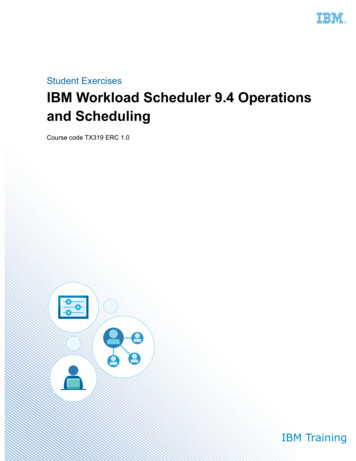
Transcription
Student ExercisesIBM Workload Scheduler 9.4 Operationsand SchedulingCourse code TX319 ERC 1.0IBM Training
October 2017 editionNOTICESThis information was developed for products and services offered in the USA.IBM may not offer the products, services, or features discussed in this document in other countries. Consult your local IBMrepresentative for information on the products and services currently available in your area. Any reference to an IBM product, program,or service is not intended to state or imply that only that IBM product, program, or service may be used. Any functionally equivalentproduct, program, or service that does not infringe any IBM intellectual property right may be used instead. However, it is the user'sresponsibility to evaluate and verify the operation of any non-IBM product, program, or service.IBM may have patents or pending patent applications covering subject matter described in this document. The furnishing of thisdocument does not grant you any license to these patents. You can send license inquiries, in writing, to:IBM Director of LicensingIBM CorporationNorth Castle Drive, MD-NC119Armonk, NY 10504-1785United States of AmericaThe following paragraph does not apply to the United Kingdom or any other country where such provisions are inconsistent with locallaw: INTERNATIONAL BUSINESS MACHINES CORPORATION PROVIDES THIS PUBLICATION "AS IS" WITHOUT WARRANTY OFANY KIND, EITHER EXPRESS OR IMPLIED, INCLUDING, BUT NOT LIMITED TO, THE IMPLIED WARRANTIES OFNON-INFRINGEMENT, MERCHANTABILITY OR FITNESS FOR A PARTICULAR PURPOSE. Some states do not allow disclaimer ofexpress or implied warranties in certain transactions, therefore, this statement may not apply to you.This information could include technical inaccuracies or typographical errors. Changes are periodically made to the information herein;these changes will be incorporated in new editions of the publication. IBM may make improvements and/or changes in the product(s)and/or the program(s) described in this publication at any time without notice.Any references in this information to non-IBM websites are provided for convenience only and do not in any manner serve as anendorsement of those websites. The materials at those websites are not part of the materials for this IBM product and use of thosewebsites is at your own risk.IBM may use or distribute any of the information you supply in any way it believes appropriate without incurring any obligation to you.Information concerning non-IBM products was obtained from the suppliers of those products, their published announcements or otherpublicly available sources. IBM has not tested those products and cannot confirm the accuracy of performance, compatibility or any otherclaims related to non-IBM products. Questions on the capabilities of non-IBM products should be addressed to the suppliers of thoseproducts.This information contains examples of data and reports used in daily business operations. To illustrate them as completely as possible,the examples include the names of individuals, companies, brands, and products. All of these names are fictitious and any similarity tothe names and addresses used by an actual business enterprise is entirely coincidental.TRADEMARKSIBM, the IBM logo, and ibm.com are trademarks or registered trademarks of International Business Machines Corp., registered in manyjurisdictions worldwide. Other product and service names might be trademarks of IBM or other companies. A current list of IBMtrademarks is available on the web at “Copyright and trademark information” at www.ibm.com/legal/copytrade.shtml.Adobe, the Adobe logo, PostScript, and the PostScript logo are either registered trademarks or trademarks of Adobe SystemsIncorporated in the United States, and/or other countries.Cell Broadband Engine is a trademark of Sony Computer Entertainment, Inc. in the United States, other countries, or both and is usedunder license therefrom.Intel, Intel logo, Intel Inside, Intel Inside logo, Intel Centrino, Intel Centrino logo, Celeron, Intel Xeon, Intel SpeedStep, Itanium, andPentium are trademarks or registered trademarks of Intel Corporation or its subsidiaries in the United States and other countries.IT Infrastructure Library is a Registered Trade Mark of AXELOS Limited.ITIL is a Registered Trade Mark of AXELOS Limited.Java and all Java-based trademarks and logos are trademarks or registered trademarks of Oracle and/or its affiliates.Linear Tape-Open, LTO, the LTO Logo, Ultrium, and the Ultrium logo are trademarks of HP, IBM Corp. and Quantum in the U.S. andother countries.Linux is a registered trademark of Linus Torvalds in the United States, other countries, or both.Microsoft, Windows, Windows NT, and the Windows logo are trademarks of Microsoft Corporation in the United States, other countries,or both.UNIX is a registered trademark of The Open Group in the United States and other countries. Copyright International Business Machines Corporation 2017.This document may not be reproduced in whole or in part without the prior written permission of IBM.US Government Users Restricted Rights - Use, duplication or disclosure restricted by GSA ADP Schedule Contract with IBM Corp.
ContentsAbout these exercises . . . . . . . . . . . . . . . . . . . . . . . . . . . . . . . . . . . . . . . . . . . . . . . . . . . . . . . . . . . . . vThe Workload Scheduler network in your lab . . . . . . . . . . . . . . . . . . . . . . . . . . . . . . . . . . . . . . . . . . . . . . . . viUnit 1 Introduction to IBM Workload Automation exercises. . . . . . . . . . . . . . . . . . . . . . . . . . . . . . 1-1About IBM Workload Scheduler V9.4 . . . . . . . . . . . . . . . . . . . . . . . . . . . . . . . . . . . . . . . . . . . . . . . . . . . . . 1-1Exercise 1 Logging on and preparing the system . . . . . . . . . . . . . . . . . . . . . . . . . . . . . . . . . . . . . . . . . . 1-2Exercise 2 Using the Welcome Page . . . . . . . . . . . . . . . . . . . . . . . . . . . . . . . . . . . . . . . . . . . . . . . . . . . 1-4Exercise 3 Creating and managing engines and configuration settings . . . . . . . . . . . . . . . . . . . . . . . . . 1-8Exercise 4 Logging out of the Dynamic Workload Console . . . . . . . . . . . . . . . . . . . . . . . . . . . . . . . . . . 1-10Exercise 5 Using the command-line interfaces . . . . . . . . . . . . . . . . . . . . . . . . . . . . . . . . . . . . . . . . . . . 1-11Setting up the command-line environment . . . . . . . . . . . . . . . . . . . . . . . . . . . . . . . . . . . . . . . . . . . . . . 1-11Starting to use the console manager . . . . . . . . . . . . . . . . . . . . . . . . . . . . . . . . . . . . . . . . . . . . . . . . . . . 1-11Starting to use the composer program . . . . . . . . . . . . . . . . . . . . . . . . . . . . . . . . . . . . . . . . . . . . . . . . . 1-12Unit 2 Using the Application Lab interface exercises . . . . . . . . . . . . . . . . . . . . . . . . . . . . . . . . . . . 2-1Exercise 1 Using the Application Lab interface . . . . . . . . . . . . . . . . . . . . . . . . . . . . . . . . . . . . . . . . . . . . 2-2Optionally, following the built-in tutorial . . . . . . . . . . . . . . . . . . . . . . . . . . . . . . . . . . . . . . . . . . . . . . . . . . 2-4Exercise 2 Managing processes . . . . . . . . . . . . . . . . . . . . . . . . . . . . . . . . . . . . . . . . . . . . . . . . . . . . . . . 2-5Using the process library . . . . . . . . . . . . . . . . . . . . . . . . . . . . . . . . . . . . . . . . . . . . . . . . . . . . . . . . . . . . . 2-5Creating a process library . . . . . . . . . . . . . . . . . . . . . . . . . . . . . . . . . . . . . . . . . . . . . . . . . . . . . . . . . . . . 2-6Creating a process . . . . . . . . . . . . . . . . . . . . . . . . . . . . . . . . . . . . . . . . . . . . . . . . . . . . . . . . . . . . . . . . . 2-6Running and monitoring a process . . . . . . . . . . . . . . . . . . . . . . . . . . . . . . . . . . . . . . . . . . . . . . . . . . . . 2-11Exercise 3 Using other Application Lab functions . . . . . . . . . . . . . . . . . . . . . . . . . . . . . . . . . . . . . . . . . 2-13Unit 3 Monitoring Workload Scheduler production exercises . . . . . . . . . . . . . . . . . . . . . . . . . . . . 3-1Exercise 1 Using the Direct Query feature in Dynamic Workload Console . . . . . . . . . . . . . . . . . . . . . . . 3-2Exercise 2 Using the Workload Dashboard . . . . . . . . . . . . . . . . . . . . . . . . . . . . . . . . . . . . . . . . . . . . . . . 3-7Exercise 3 Monitoring workstations . . . . . . . . . . . . . . . . . . . . . . . . . . . . . . . . . . . . . . . . . . . . . . . . . . . . . 3-9Exercise 4 Monitoring Workload Broker Computers . . . . . . . . . . . . . . . . . . . . . . . . . . . . . . . . . . . . . . . 3-13Exercise 5 Monitoring workstations by using the command-line interface . . . . . . . . . . . . . . . . . . . . . . 3-15Exercise 6 Monitor scheduling objects . . . . . . . . . . . . . . . . . . . . . . . . . . . . . . . . . . . . . . . . . . . . . . . . . 3-16Exercise 7 Monitoring by using the command-line interface . . . . . . . . . . . . . . . . . . . . . . . . . . . . . . . . . 3-18Exercise 8 Monitoring the plan graphically by using the Plan View . . . . . . . . . . . . . . . . . . . . . . . . . . . . 3-19Unit 4 Managing Workload Scheduler production exercises . . . . . . . . . . . . . . . . . . . . . . . . . . . . . 4-1Exercise 1 Managing workstations in the plan . . . . . . . . . . . . . . . . . . . . . . . . . . . . . . . . . . . . . . . . . . . . 4-2Exercise 2 Managing other dependencies in the plan . . . . . . . . . . . . . . . . . . . . . . . . . . . . . . . . . . . . . . . 4-4Exercise 3 Managing workstations and dependencies by using the command-line interface . . . . . . . . . 4-9Exercise 4 Submitting new work, releasing, and canceling jobs . . . . . . . . . . . . . . . . . . . . . . . . . . . . . . 4-11Exercise 5 Using the What-If Interface . . . . . . . . . . . . . . . . . . . . . . . . . . . . . . . . . . . . . . . . . . . . . . . . . 4-19 Copyright IBM Corp. 2017Course materials may not be reproduced in whole or in part without the prior written permission of IBM.iii
V7.0ContentsUemptyUnit 5 Creating scheduling objects exercises . . . . . . . . . . . . . . . . . . . . . . . . . . . . . . . . . . . . . . . . . 5-1Exercise 1 Using the Workload Designer . . . . . . . . . . . . . . . . . . . . . . . . . . . . . . . . . . . . . . . . . . . . . . . . 5-2Exercise 2 Creating a variable table . . . . . . . . . . . . . . . . . . . . . . . . . . . . . . . . . . . . . . . . . . . . . . . . . . . . 5-4Exercise 3 Creating calendars . . . . . . . . . . . . . . . . . . . . . . . . . . . . . . . . . . . . . . . . . . . . . . . . . . . . . . . . . 5-6Exercise 4 Creating run cycle groups . . . . . . . . . . . . . . . . . . . . . . . . . . . . . . . . . . . . . . . . . . . . . . . . . . . 5-8Exercise 5 Creating job definitions . . . . . . . . . . . . . . . . . . . . . . . . . . . . . . . . . . . . . . . . . . . . . . . . . . . . 5-10Creating the File Transfer job . . . . . . . . . . . . . . . . . . . . . . . . . . . . . . . . . . . . . . . . . . . . . . . . . . . . . . . . 5-10Creating the file monitor job . . . . . . . . . . . . . . . . . . . . . . . . . . . . . . . . . . . . . . . . . . . . . . . . . . . . . . . . . 5-12Creating the file process job . . . . . . . . . . . . . . . . . . . . . . . . . . . . . . . . . . . . . . . . . . . . . . . . . . . . . . . . . 5-13Exercise 6 Creating jobs with conditions . . . . . . . . . . . . . . . . . . . . . . . . . . . . . . . . . . . . . . . . . . . . . . . . 5-15Unit 6 Scheduling, forecasting, and migrating workloads exercises. . . . . . . . . . . . . . . . . . . . . . . 6-1Exercise 1 Creating a job stream . . . . . . . . . . . . . . . . . . . . . . . . . . . . . . . . . . . . . . . . . . . . . . . . . . . . . . 6-2Adding jobs to a job stream . . . . . . . . . . . . . . . . . . . . . . . . . . . . . . . . . . . . . . . . . . . . . . . . . . . . . . . . . . . 6-3Adding job dependencies . . . . . . . . . . . . . . . . . . . . . . . . . . . . . . . . . . . . . . . . . . . . . . . . . . . . . . . . . . . . 6-4Adding run cycles . . . . . . . . . . . . . . . . . . . . . . . . . . . . . . . . . . . . . . . . . . . . . . . . . . . . . . . . . . . . . . . . . . 6-6Exercise 2 Creating job streams with conditional dependencies . . . . . . . . . . . . . . . . . . . . . . . . . . . . . . . 6-7Monitoring your job stream . . . . . . . . . . . . . . . . . . . . . . . . . . . . . . . . . . . . . . . . . . . . . . . . . . . . . . . . . . 6-12Exercise 3 Selecting jobs to use advanced statistics . . . . . . . . . . . . . . . . . . . . . . . . . . . . . . . . . . . . . . 6-14Exercise 4 Setting time restrictions . . . . . . . . . . . . . . . . . . . . . . . . . . . . . . . . . . . . . . . . . . . . . . . . . . . . 6-16Exercise 5 Creating event rules . . . . . . . . . . . . . . . . . . . . . . . . . . . . . . . . . . . . . . . . . . . . . . . . . . . . . . . 6-19Checking if the event rule is active . . . . . . . . . . . . . . . . . . . . . . . . . . . . . . . . . . . . . . . . . . . . . . . . . . . . 6-21Testing the event rule . . . . . . . . . . . . . . . . . . . . . . . . . . . . . . . . . . . . . . . . . . . . . . . . . . . . . . . . . . . . . . 6-21Exercise 6 Using workload application templates . . . . . . . . . . . . . . . . . . . . . . . . . . . . . . . . . . . . . . . . . 6-23Exercise 7 Importing application templates . . . . . . . . . . . . . . . . . . . . . . . . . . . . . . . . . . . . . . . . . . . . . . 6-26Exercise 8 Importing crontab definitions . . . . . . . . . . . . . . . . . . . . . . . . . . . . . . . . . . . . . . . . . . . . . . . . 6-28Exercise 9 Creating and viewing a forecast . . . . . . . . . . . . . . . . . . . . . . . . . . . . . . . . . . . . . . . . . . . . . 6-30Unit 7 Reporting with Workload Scheduler exercises . . . . . . . . . . . . . . . . . . . . . . . . . . . . . . . . . . . 7-1Exercise 1 Creating a job statistics report . . . . . . . . . . . . . . . . . . . . . . . . . . . . . . . . . . . . . . . . . . . . . . . .Exercise 2 Creating a job history report . . . . . . . . . . . . . . . . . . . . . . . . . . . . . . . . . . . . . . . . . . . . . . . . .Exercise 3 Creating a custom SQL report . . . . . . . . . . . . . . . . . . . . . . . . . . . . . . . . . . . . . . . . . . . . . . . .Exercise 4 Using the Common Reporting tool . . . . . . . . . . . . . . . . . . . . . . . . . . . . . . . . . . . . . . . . . . . . .7-27-47-67-8Appendix A Troubleshooting . . . . . . . . . . . . . . . . . . . . . . . . . . . . . . . . . . . . . . . . . . . . . . . . . . . . . . A-1 Copyright IBM Corp. 2017Course materials may not be reproduced in whole or in part without the prior written permission of IBM.iv
About these exercisesIBM Workload Scheduler is part of the IBM Workload Automation suite of products. With IBMWorkload Scheduler, you can automate and control your entire enterprise production workload. IBMWorkload Scheduler is a middleware product that is commonly known as a batch job scheduler, orjob scheduler. Job schedulers automatically drive work in mainframe and non-mainframeenvironments.Workload Scheduler maintains a database of production scheduling objects such as workstations,jobs, resources, and calendars, and assembles them into a plan. The plan contains the list of theworkload to complete within the planned production period. When all conditions and prerequisitesare satisfied, the agent runs the workload components and reports the outcome.In the lab exercises, you learn how to schedule batch jobs in IBM Workload Scheduler. You use theDynamic Workload Console to create job definitions, scheduling object definitions, and job streamdefinitions. You submit job streams that you created and monitor their outcomes. Copyright IBM Corp. 2017Course materials may not be reproduced in whole or in part without the prior written permission of IBM.v
V7.0About these exercisesThe Workload Scheduler network in your labUemptyThe Workload Scheduler network in your labIn the exercises for this class, you log in to the system by using the parameters listed in thefollowing table.Table 1 IBM Workload Scheduler learning environmentParameterDefault valueMaster workstationMDM0Host namews94mdm0User IDswsuser, wauser, db2inst1, rootPasswordobject00Dynamic Workload Console URLhttps://ws94mdm0:16311/ibm/consoleYour learning station contains a virtual computer that runs on a virtual network. The computercontains Workload Scheduler components, as shown. A Master Domain Manager controls anetwork of dynamic agents. The dynamic agents are collected into pool and dynamic poolworkstations.Docker containers provide additional dynamic agents that you use to learn about monitoring andcreating dynamic pool workstations.Login names that you use during the exercises in this class are wsuser, and other names in theLDAP directory. The password for each user is object00.The URL for the IBM Dynamic WorkloadConsole is http://localhost:16311/ibm/console. Copyright IBM Corp. 2017Course materials may not be reproduced in whole or in part without the prior written permission of IBM.vi
V7.0About these exercisesThe Workload Scheduler network in your labUemptyLogin names from the directory server that you use during the exercises in this class are listed inTable 2 The password for each user is object00.Table 2 User names in the directoryUser wsAnalyststipusersAdeline DurlingadurlingYYYYYAriana BramanabramanBart WinebargerbwinebargerYDick SelandselanYEarline AngeeangeElse ZegarelliezegarelliEmeldaLotempioelotempioYGerald BailliogbaillioYYHouston DoldhdoldYYJaime VassojvassoJasperGuglielmojguglielmoJorge HolzheimerkholzheimerYKory n ha FowbletfowbleYYYZackary YYYYYYYYYYY Copyright IBM Corp. 2017Course materials may not be reproduced in whole or in part without the prior written permission of IBM.vii
V7.0About these exercisesThe Workload Scheduler network in your labUempty Copyright IBM Corp. 2017Course materials may not be reproduced in whole or in part without the prior written permission of IBM.viii
Unit 1 Introduction to IBM WorkloadAutomation exercisesIn the exercises for this unit, you review the enhancements that are available in WorkloadScheduler V9.4, and prepare your environment for the exercises in the next unit. You start theDynamic Workload Console and use the conman and composer commands.About IBM Workload Scheduler V9.4IBM Workload Scheduler V9.4 automates running batch and near real-time work loads andactivities that support business services. It helps provide the reliable and Service Level Agreement(SLA) compliant delivery of these business services. Workload Scheduler extends automationcapabilities to heterogeneous systems, and manages work flows that integrate mainframeapplications with distributed applications, Enterprise Resource Planning (ERP), and businessintelligence applications.Workload Scheduler offers mechanisms for resource virtualization and uses cloud technologies,which helps to minimize fixed costs. Workload Scheduler includes a modern web-based interface,called the Dynamic Workload Console, for operations, monitoring, scheduling, administrative tasks,and reporting. It offers self-service catalog for mobile devices to show scheduling services tobusiness users in a natural way.IBM Workload Automation V9.4 integrates with existing data center systems and cloud resourcesand applications. It delivers improved productivity for the daily operations of IT administrators andschedulers. Copyright IBM Corp. 2017C
IBM Workload Scheduler is part of the IBM Workload Automation suite of products. With IBM Workload Scheduler, you can automate and contro l your entire enterprise production workload. IBM Workload Schedu
